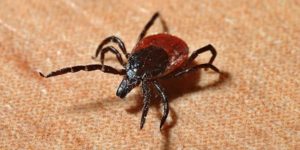 HYANNIS – U.S. Health officials have reported a record number of tick-borne disease cases last year.
HYANNIS – U.S. Health officials have reported a record number of tick-borne disease cases last year.
The Centers for Disease Control and Prevention recently announced that more than 59,000 cases were reported in 2017 across the country, which was an increase of 22 percent from 2016.
Lyme disease accounted for about three-quarters of the illnesses, or about 43,000 cases.
The average number of cases of Lyme disease reported by the government each year is around 30,000, but experts believe they were underreported with the actually number about 10 times that amount.
“Over the last 15 years we’ve seen a steady increase in tick-borne diseases,” said Dr. Ben Beard, the Deputy Director of Vector Borne Diseases with the CDC.
Beard said over the last two decades the increase in tick-borne illnesses can be attributed to changes in land-use patterns, increases in deer populations and growth of suburban areas.
Changing climate may also have helped contribute to the increase through the population size of ticks and the northward expansion of the species.
In Massachusetts, the tick-borne diseases that cause the most concern are Lyme disease, Anaplasmosis and Babesiosis.
Dr. Catherine Brown with the Massachusetts Department of Public Health said the increase in reported cases is not a surprise to tick-borne disease researchers, especially in Massachusetts which was a focal point for tick-borne disease activity.
Browns said the message stressing prevention has not changed.
“The things that people can do to help protect themselves, include using tick repellents regularly,” she said. “One of things to think about is using a repellent that has an EPA registered active ingredient.”
To get EPA registered, the company which manufactures the repellent had to prove that the product is effective and safe.
Brown also recommends covering skin with clothing as much as possible, along with conducting daily tick checks during the active season, which is typically from April to October.
“The take away from this report is that we need to continue those outreach programs, continue to raise awareness and to promote these prevention activities,” Brown said.
Better reporting may have led to the increase in cases, but scientists are discovering more tick-transmitted diseases.
By BRIAN MERCHANT, CapeCod.com NewsCenter
Material from the Associated Press was used in this article.
























